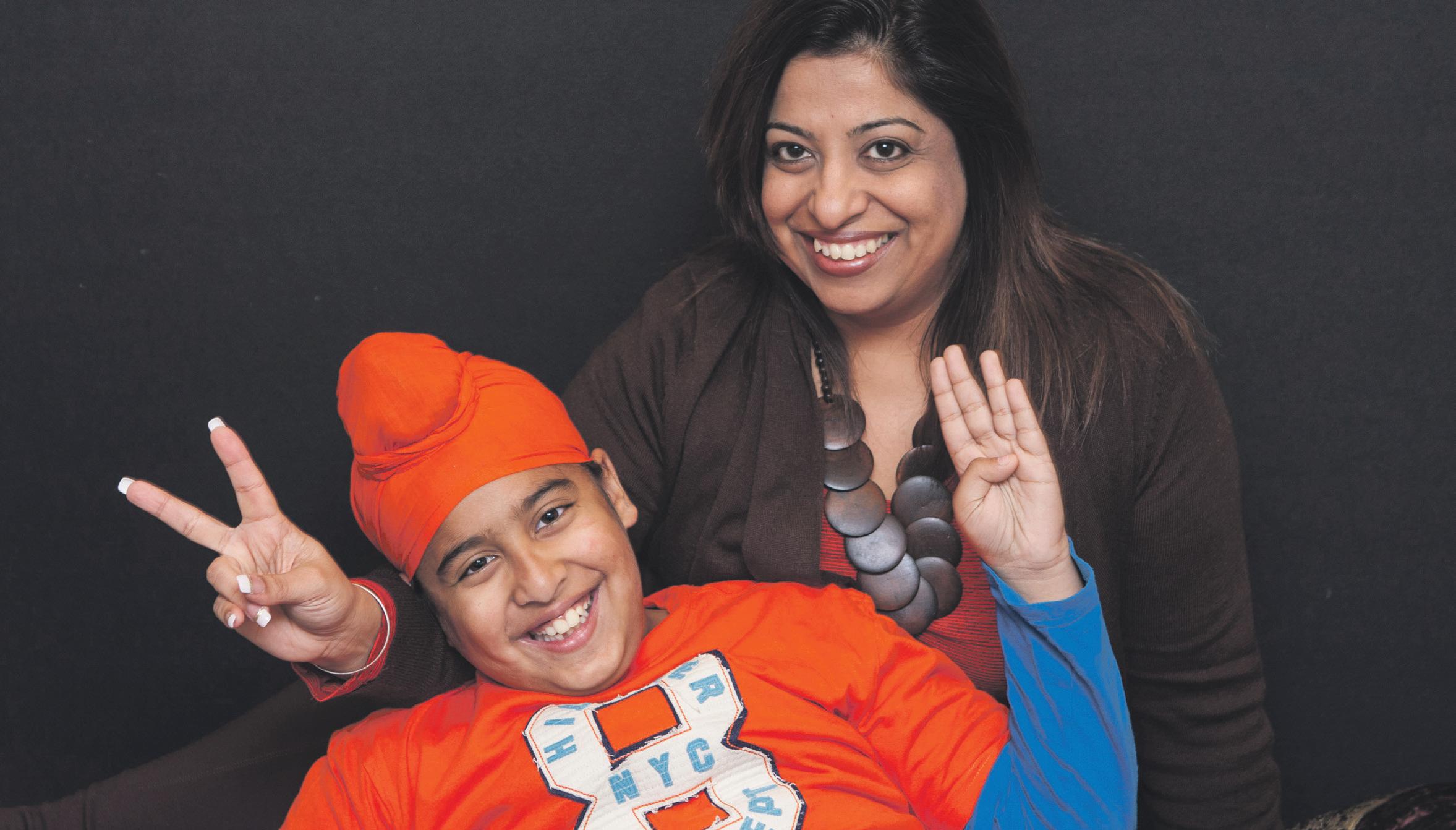
6 minute read
Building self-confidence and resilience
from 2012-12 Sydney (1)
by Indian Link
BY MOHAN DHALL
Parents and educators often assert that they would like children to have a healthy self-esteem and to be resilient in the face of change and uncertainty. ‘Self-esteem’ is a nebulous concept and it is more probable that parents and educators use the term to indicate that they want their children to have confidence and a belief in their own abilities. In practice this should be seen when a child shows determination when faced with difficulty, who will make repeated efforts to master something when failure has been experienced, and who will also know when to stop if something is not quite working out.
Encouragement
It is often assumed that encouragement is all that is required to build a healthy selfconcept. Praising a child can be very appropriate in reinforcing desired behaviour. However in my experience, over-praising a child is actually counterproductive for several reasons. Firstly, overpraising gives a child no room to grow. After all, from where can a child grow? “That is SO awesome and I am numb with amazement”. Secondly, too much praise can make a child seek outside affirmation and can actually reduce the capacity for child to develop their own personal standards against which to strive. Thirdly, over praise tends to focus on what is done (the outcome), rather than on how achievement feels. Thus, the outcome can be affirmed when the processes matter more.
A more confidence-building approach to encouragement would take the form of noting elements of performance and the journey. Thus, acknowledging effort through observations such as: “I notice that when you try your best you seem most happy?” or “It is good to do well and I can see you are happy. What makes me happy is that you are pleased with your effort.”
Sometimes what appears to be encouragement can actually be quite destructive implied criticism. This is particularly the case when the prompt to encourage comes from a parent or teacher’s desire to have their own values and standards imposed on another.
So, for example, a well-meaning parent may encourage hours of study or revision to instil an understanding of academic excellence and success.
However, some children struggle academically and may feel like the ‘encouragement’ places them under pressure. Worse, it can actually undermine the child’s sense of worth because they will always feel not good enough. I meet so many children who are far behind their eyes because they are not like their academically high achieving older (or younger) brother or sister.
Articulating the struggle for the child is a good foundational step in building a sense of understanding and empathy. After all, children who understand themselves are likely to be less self-critical and more self-aware. This is intrinsic to feelings of self-confidence and self-worth. In this way a child can learn what they find hard and then learn to manage strategies around dealing with things they find difficult.
Friendships
One significant area where self esteem and inner confidence can be built arises in the realm of friendships. All parents and educators know that friendships come and go, they change and they can be a source of great happiness and sometimes also great pain.
If a child asserts that they are excluded from a friendship group it is common for a parent or teacher to reassure them by saying, “Just try harder” or
“Friendships don’t matter” or even “If you show initiative and be confident they will follow”. None of these statements actually embodies close listening or understanding. A response like “Sometimes you feel left out and that makes you feel a bit lonely” is more likely to foster a sense in the child that the adult understands them. It may also lead to tears. Protective parents and teachers may be more interested in solving the problem that being still with feelings and managing tears. Tears however, dry.
Unfortunately, a focus on solving the problem generally applies logic and rationalisation and misses the feelings aspect, thus undermining a child. Undermining and non-validation can last much longer.
This type of listening articulates and normalises feelings and is basic to validating a child. It also gives the children an opportunity to further refine their own values, thoughts and feelings around the issue.
Parents and teachers may ask, “But doesn’t this simply instil in the child a sense of negativity?” After all, articulating feelings of being left out and lonely sounds all very negative. The reality is, in fact, otherwise. Starting with what is real means that the child can learn to articulate at least what is happening within them. This is essential as self-understanding builds self-awareness and also confidence. It also leads to a better understanding of others. After a child knows they are understood, a discussion about inclusion and friendships can be broadened. In this way, the issue can be dealt with, whilst boosting the child and increasing their independence and capacity to understand.
Learning to fail
Learning to ‘fail’ can be a significant source of learning, maturing and growth. Both self confidence and resilience (‘stickability’) can be nurtured in an environment where the process matters at least as much as the product. Setting goals and challenging oneself to achieve them can place a child under pressure to perform. Goals can bring out the best in us, can encourage focused effort and also bring attention to helping a person be their best. In doing so, a person learns about himself.
When a goal is set but not achieved, it is often characterised as ‘failure’ or rationalised through excuses and logic. But the real feelings of disappointment need to be articulated and felt rather than suppressed, as otherwise there can be significant emotional blocks to taking a risk and trying. In this way, achievement and effort can be understood and resilience built. Following articulation, parents and teachers can guide the child through the self-talk required for restoration. Thus, moving from “Sometimes it can be disappointing when we miss out on something we want” (articulation of feelings) to “If you were to give it another go, what would you do differently and how could I support you with that?” (resilience and support).

Praising a child can be very appropriate in reinforcing desired behaviour. However, overpraising is actually counterproductive.
An approach like this makes non-achievement of goals less likely to be perceived as failure, and much more likely to be a learning and confidence-building experience. As children get to know themselves, they can get better at setting goals and learning how to adjust to changes, and they can focus on the process of achievement, rather than purely on the outcomes.
In summary
We all want children to learn to be independent, confident and resilient. These notable qualities are built through the way the normal stuff of life is managed. Too often parents and educators bring a rational, linear and logical approach to solving problems and being supportive. However, often well-meaning support is misplaced and actually undermines the child.
Starting with the child and affirming them for who they are is likely to build self-esteem, self-understanding and feeling of confidence. Moreover, a focus on the means and processes helps children to integrate feelings and thus understand themselves whilst also learning about the nature of achievement and resilience.


Grab attention with army jackets, skinny cargo pants and lace-up boots

BY TALIA KAUR
Military fashion as a trend is nothing new; in fact, it’s been on the rise since 2008, coming back every few seasons; but this time it seems like it’s here to stay. In 2012 we saw the military trend evolve from a tough edgy look to a more chic look in collections by Alexander Wang, Tommy Hilfiger and Victoria Beckham. Items like army jackets, skinny cargo pants and lace-up boots are easy ways to wear this trend and of course, the earthy palette of olive greens and neutrals along with clean cuts is a perfect compliment to every wardrobe. This is a perfect trend to take advantage of – once you get a few staple military pieces in your wardrobe and you know how to style them to suit your personality, you’ll be set for many seasons to come! Here are a few ways to rock your military chic look.

Rock Chic
This style is all about toughening up your look with detailing such as structured jackets, shoulder pads and large gold buttons. Gold detailing and ornate trims really set off the slick military cuts and add a little extra energy to your outfit. An easy way to pull off the rock chic look is with a simple, yet edgy military jacket – it’s a musthave! These can be of various types with different lengths, fabrics, cuts, embellishments and shades – just experiment and wear a jacket that feels comfortable and reflects your personality so you feel confident when wearing it. A personal favourite that gives a great edge to an outfit is a khaki coloured jacket with black leather sleeves. Pair it with some black skinny pants or shiny leggings and studded ankle boots or even a pair of killer heels, and you’ve got yourself the ultimate rock chic military outfit.

Feminine
The key to keeping military looks feminine is to choose fitted pieces. The most feminine way of wearing this trend would have to be by wearing skirts. Military skirts ending just above the knee are classy and versatile – team them up with a white or nude formal shirt to dress it up, or a plain black or white t-shirt to















